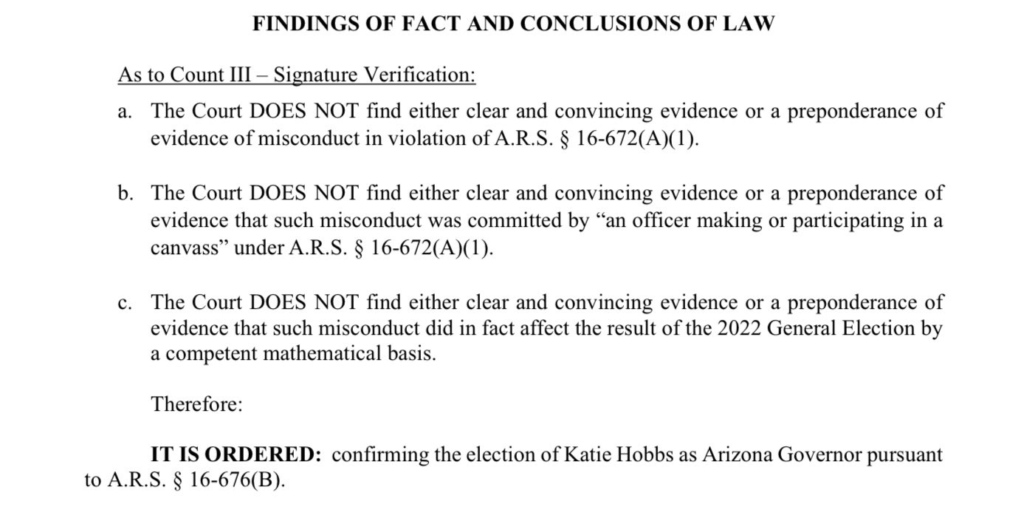Maricopa County Superior Court Judge Peter Thompson rejected Kari Lake’s claims that improper signature verification and misconduct impacted the result of Arizona’s 2022 gubernatorial election.
Thompson made the ruling despite the evidence presented by Lake’s legal team.
“Maricopa County ‘verified’ roughly 70,000 signatures in two seconds and approved 264,000 ballots in less than three seconds. These are numbers from their own system logs. That’s not humanly possible. And it’s not signature verification. Not even close,” Lake previously tweeted.
WATCH:
The Western Journal noted:
The November race between Republican Kari Lake and Democratic Gov Katie Hobbs “was decided by 17,117 votes.
That, however, is out of 2.59 million votes, a difference between the two candidates of 0.67 percent,” he said.
“The number of ballots at issue whether the court were to set aside for illegality, the 70,000, the 274,000 in a proportional manner … this election should be set aside,” Olsen added.
Moreover, the signature verification process Maricopa County purportedly uses is highly subjective, claimed Lake and her legal team:
However, Judge Thompson rejected the claim.
“The court DOES NOT find either clear and convincing evidence or a preponderance of evidence of misconduct,” the ruling read.
“The court DOES NOT find either clear and convincing evidence or a preponderance of evidence that such misconduct was committed by ‘an officer making or participating in a canvass,’” it continued.
“The court DOES NOT find either clear and convincing evidence or a preponderance of evidence that such misconduct did in fact affect the result of the 2022 General Election by a competent mathematical basis,” it continued.
“IT IS ORDERED: confirming the election of Katie Hobbs as Arizona Governor,” it read.

AZ Central reported:
Lake’s legal team argued it could prove signatures were examined in a matter of seconds, so short a timeframe it did not count as verification under state law. Thompson, in a Monday night ruling, disagreed.
“Accepting that argument would require the court to re-write not only the (Election Procedures Manual) but Arizona law to insert a minimum time for signature verification and specify the variables to be considered in the process,” he wrote.
Lake has not conceded the race, which she lost by 17,117 votes, or less than 1 percentage point. Instead, she’s pressed forward in court asking judges to set aside Hobbs’ win, and is likely to appeal Thompson’s latest ruling.
FOX 10 added:
In his ruling, Judge Thompson wrote that the evidence the court received “does not support Plaintiff’s remaining claim,” and that a witness, identified only as “Ms. Onigkeit,” made it abundantly clear during her testimony that two levels of signature review took place in some fashion.
“[Ms. Onigkeit] expressed her concern that this review was done hastily and possibly not as thoroughly as she would have liked – but it was done,” a portion of the ruling read.
Another witness, identified only as “Mr. Myers,” testified that he took part in one level of signature review and curing process, according to the ruling.
Meanwhile, Valenzuela, according to the ruling, testified that two levels of signature verification and two levels of auditing took place.
“Mr. Valenzuela’s testimony, elicited by both parties, is most helpful to the Court, and the most credible,” read a portion of the ruling. “While Ms. Onigkeit and Mr. Myers have ground level experience with signature review, Mr. Valenzuela provided the Court with both a hands-on view based on the 1,600 signatures reviewed by him personally in November 2022 and a broad overview of the entire process based upon his 33 years of experience.”
In addition, Judge Thompson stated in the ruling that Valenzuela testified that the final canvass was accurate, and no clear and convincing evidence, or even a preponderance of evidence, contracts him.
Read the full ruling HERE.





The Constitutional remedy for suspected election fraud is a forensic audit by the state legislature of the state in question. Why do these unhappy losers keep going before a court?
Any sensible person who watched the video evidence, and who was capable of the least bit of reason and objectivity, would conclude that the operator performing the signature verification was simply pressing ‘enter’ as quickly as possible without consideration of forged signatures. Not once did I see the operator pause to review a signature.